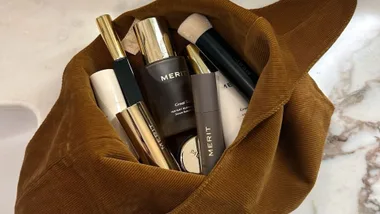As any beauty editor will tell you, wearing sunscreen daily is the most crucial step a woman can take in the crusade against an ageing complexion. But what isn’t so well known is the slew of other environmental factors at play – many of which can be found within the walls of your home.
Dermatologists agree that frequent exposure to pollution, indoors and out, can prematurely age the skin, potentially leading to such joys as a decrease in collagen levels, inflammation and pigmentation.* You may not have any say on the fumes outside, but you can police the pollution levels in your home – read on to find out how.
Scented candles
We love scented candles as much as the next person, but the key lies in choosing wisely: always read the ingredients list to ensure yours is free of chemicals that can release volatile organic compounds (VOCs) into the air as they burn. Exposure to VOCs at high levels can lead to skin irritation and allergic skin reactions**.
A BBC study, for instance, found that citrus-scented candles containing limonene can react with elements in the air to produce formaldehyde, a known carcinogen, when lit, which can lead to skin irritation as well as respiratory issues***. Instead, opt for soy or natural beeswax candles, which burn cleanly (with little to no smoke or soot) and are said to help improve air quality thanks to the negative ions they emit. The cleaner the candle, the cleaner the air in your home.
Screens
Hands up who spends their weeknights parked in front of the TV, laptop in their – um – lap and iPhone in one hand? All that screen time spells bad news for our skin. The heat and blue light those screens emit is thought to contribute to hyperpigmentation and even worsen melasma****, so try to avoid the temptation to scroll Instagram all evening to decrease your exposure to indoor light pollution.
Soft furnishings
It’s not unusual for everything from your new couch to car interior to be coated in residual chemicals from the manufacturing process (it’s also why you should always wash new clothes before you wear). Even the foam found in some textile-covered furniture can release formaldehyde gas into the air. Add to that the VOCs from a fresh lick of paint, some extra-zealous sprays of Mortein and it’s not surprising that our homes are teeming with invisible gases and fine particles – all of which contribute to indoor air pollution, which can damage our skin over time.
Incorporating greenery into your home by way of a few well-chosen pot plants will help to detoxify the air (peace lilies and English Ivy are thought to work particularly well – the latter was honoured by NASA as the best air-filtering household plant). Also consider investing in a purpose-built air purifier to control airborne pollutants and allergens and improve air quality in your home.
* https://www.dermcoll.edu.au/wp-content/uploads/Make-up-stops-skin-ageing-15-May-2017.pdf
** https://www.epa.gov/indoor-air-quality-iaq/volatile-organic-compounds-impact-indoor-air-quality
***http://www.bbc.co.uk/programmes/articles/58KFJzpJb2kyLtDPhhHqnbQ/are-perfumed-products-bad-for-me
**** https://www.ncbi.nlm.nih.gov/pubmed/24888214










